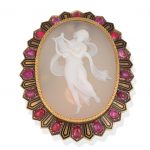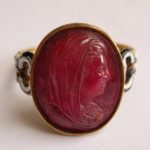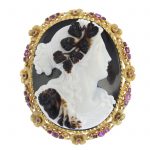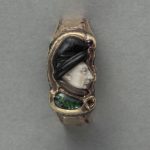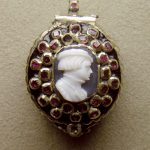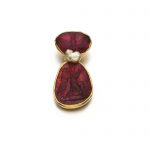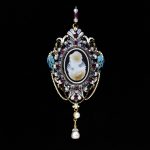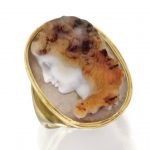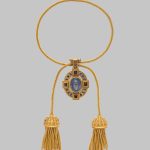Information and history of ruby cameos and cameos surrounded by rubies. Rubies are excellent gemstones for surrounding cameos. They are especially attractive when mounted in gold, as in the gold, ruby and diamond cameo pendant below. In addition they can be used for cameo engraving.
Rubies are one of the traditional cardinal gems, together with amethyst, sapphire, emerald, and diamond. Reference: Wikipedia
A gold, enamel, ruby and hardstone cameo, by Giovanni Antonio Santarelli, late 18th/early 19th century Oval, carved in low relief to depict Erato, full length, playing her lyre, within a gold frame decorated with black enamel, accented by oval cabochon rubies in foiled closed back settings, cameo cracked, signed Santarelli F., cameo: length 3.6cm, width 2.7cm, frame: length 4.9cm, width 3.9cm
Sold for £1,625 inc. premium at Bonhams in 2017
Finger-ring; gold; hoop enamelled in white on shoulders, which are pierced, design including fleur-de-lis; oval bezel ornamented on back and sides with enamel; ruby cut in cameo with female bust in classical style to right, with drapery over the head.
Reference: © The Trustees of the British Museum
Gold, Ruby and Diamond Cameo Pendant-Brooch 14 kt., 8 round diamonds ap. .70 ct., ap. 27.3 dwts.
Sold for $1,187 (includes buyer’s premium) at Doyle New York in 2014
A sardonyx and ruby cameo brooch. Of oval outline, the mid Victorian sardonyx panel, possibly depicting Bacchus, with vari-cut ruby floral surround. Length 6cms. Weight 49.6gms. CONDITION Overall condition good. Surface scratches and discolouration in keeping with general age and wear. Contains antique components. Hinged clasp with French restrike marks. Sardonyx is a banded deep brown and white hue and is in good condition with few minor nibbles. Small hairline fracture to cameo, with slight discolouration. Rubies are a pinkish-red hue, with good clarity and typical inclusions, some of which are surface reaching. Rubies are in good condition, with minor nibbles to facet edges.
Sold for £1,500 at Fellows in 2018
Ring bearing the portrait of John the Fearless, Duke of Burgundy (1371-1419; as duke, 1404-19)
This gold ring with a bezel bears the portrait of John the Fearless, Duke of Burgundy (1371-1419). Combining several techniques-chasing, enamel, precious stones, and hard stone-this delicately worked piece reflects the exquisite taste of the early fifteenth-century court.
The face is sculpted from white agate, the black jade hat is decorated with a ruby, and the emerald garment has a fur collar of beige agate. Thus the piece combines chasing, enameling, and sculpture of hard stone. Both the exterior and interior of the ring bore inscriptions in black enamel: on the interior we can still make out some of the Gothic lettering of the Latin inscription, “Truly this was the Son of God,” uttered by one of the Roman centurions after Jesus’ death (Matthew 27:54, Mark 15:39). Unfortunately, the inscription on the outside is now totally effaced. On the underside of the bezel, however, we can readily make out an engraved planing tool overlaid with orange-yellow enamel. The use of such emblems was widespread in the late Middle Ages and this one was adopted by John the Fearless in 1406. Cameo rings of this kind were very much in fashion at the time and we know that John of Berry, the Duke’s uncle, had two of them. In its traditional combining of gold and colored stones, this piece reflects the fashion and taste for luxury of the style prevailing in the fifteenth century’s first decade.
Reference:The Louvre
Watchmaker: Wilhelm Peffenhauser (German, Augsburg, born 1618, master 1647, died before 1683) Artist:Cameo cut by P. Schweyger (active Augsburg, 1540–50) Date:watch ca. 1650, cameo 16th–17th century
Case: agate cameo, with cover of enameled gold set with gemstones (rubies); Dial: engraved gold and silver; Movement: gilded brass and steel, partly blued
Reference: The Metropolitan Museum of Art
Ruby cameo pendant, Early 19th century/late 20th century Set with two carved ruby cameos, the principle cameo carved to depict the profile of a kneeling winged angel, surmounted by a smaller cameo carved to depict a winged dove, emblematic of the Holy Spirit, to a later foil backed collet mount embellished with a single baroque cultured pearl.
Sold for 68,750 GBP at Sothebys in 2017
Pendant, enamelled gold set with rubies, sapphires and pearls, and with an onyx cameo portrait of Marie de Medici. The cameo signed: G. Bissinger, and numbered: 3204. Locket fitting at the back; drop with two pearls. The gold work bears Carlo Giuliano’s first mark.
In the 19th century many designers used historical styles. This piece looks back to the elaborate pendants of the Renaissance with their colourful enamelled gold frames and central cameo portraits. Carlo Giuliano, who made the setting for the pendant about 1865, was inspired by designs of the 16th and 17th centuries. His jewellery company made delicate enamelled pieces that remained popular into the 20th century.
Reference: © Victoria and Albert Museum
